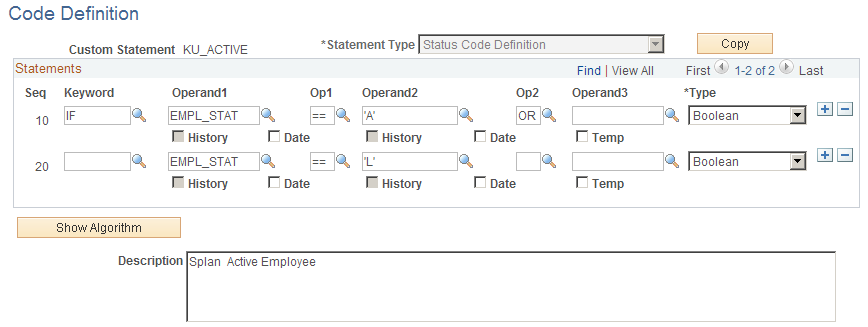Defining Status Criteria for Active and Terminated Employees
To define status criteria for employees, use the Code Definition (STATUS_CODE_DEFINT) and Codes (STATUS_ASSIGNMENT) components.
This topic provides an overview of pension status code usage with multiple jobs and discuss how to define status criteria.
|
Page Name |
Definition Name |
Usage |
|---|---|---|
|
PA_CUSTOM_PNL |
Define a pension status code. |
|
|
PA_STAT_ASSGNMT |
Assign a status code definition to a pension status code. You must first create a status code definition on the Code Definition page. |
Multiple jobs processing adds an additional level of complexity to pension status code usage. A pension status is for an employee, rather than a job.
When you use multiple jobs processing for the pension status codes that are maintained by periodic processing and user-defined criteria (ANP, APR, AVS, ANS, A70, TNV, and TDF), you do not need to specify whether an employee is active or inactive in the criteria. This is because you define what constitutes an active participant on the Active/Inactive Job and Plan Aliases pages.
For these seven pension status codes, you designate the active and inactive status when you assign the codes to custom statements. The active statuses (ANP, APR, AVS, ANS, and A70) apply only to active employees (using the active definition that you set up on the Active/Inactive Job page). The inactive statuses, TNV and TDF, apply only to inactive employees.
Multiple jobs processing provides access to additional information for the service status. This enables you to determine whether a participant is in a period of service credit eligibility.
Use the Code Definition page (PA_CUSTOM_PNL) to define a pension status code.
Navigation:
This example illustrates the fields and controls on the Code Definition page.

A status code definition contains an IF statement that identifies the criteria for inclusion in this category—for example, the criteria for identifying active employees.
You must first set up the status code definitions on this page. Then, on the Status Code Assignment page, you assign a definition to each pension status code (you can reuse definitions, if appropriate).
Note: Because the pension status codes determine how participants are categorized for Form 5500 participant counts, be sure that your definitions categorize participants appropriately for regulatory reporting.
You do not need to use all of the valid pension status codes, but make sure that all participants belong to only one of the categories that you use. The statement type is always Status Code Definition.
Field or Control |
Description |
|---|---|
Copy |
Status code definitions can be complex. You can use the Copy button as a shortcut if you have multiple similar statements. To use it:
The system clones the original statement using the new name. You can then make minor adjustments to the new statement. If you must make major adjustments, consider creating a new definition instead. |
Statements
You can use IN clauses (that is, clauses with the keyword IN) to check for several different values for a single field. For example, you can determine whether the employee status has one of these values: active, leave, or leave with pay. When you use an IN clause, you assign a temporary variable to the result, as shown in this example:
|
Keyword |
Operand1 |
Op1 |
Operand2 |
Op2 |
Operand3 |
Type |
|---|---|---|---|---|---|---|
|
IN |
EMPL_STATUS |
|
"active" |
|
|
Function |
|
|
"leave" |
|
"leave with pay" |
= |
TEMPC01 |
Function |
You can set up as many IN clauses as necessary. Then, when you set up an IF statement, you check the temporary variables, as shown in this example:
|
Keyword |
Operand1 |
Op1 |
Operand2 |
Op2 |
Operand3 |
Type |
|---|---|---|---|---|---|---|
|
IF |
TEMPC01 |
== |
"Y" |
AND |
|
Boolean |
|
|
TEMPC02 |
== |
"Y" |
|
|
Boolean |
This technique is useful when you check a large set of valid values. Because the IN statement uses an implied OR condition, it separates all of the OR clauses from the AND clauses of the final IF statement.
Use the Status Code Assignment page (PA_STAT_ASSGNMT) to assign a status code definition to a pension status code. You must first create a status code definition on the Code Definition page.
Navigation:
This example illustrates the fields and controls on the Status Code Assignment page.

You must create a status code assignment for each plan. You can reuse definitions, if appropriate.
Field or Control |
Description |
|---|---|
Pension Status |
Select a pension status code. |
Custom Statement |
Select the associated status code definition. |
Map real definitions only for the seven statuses that are set by periodic processing (A70, ANP, ANS, APR, AVS, TDF, and TNV).